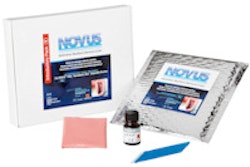
Since being introduced to the market in 2010, SureFil SDR Flow (Dentsply Caulk) has been tried by more than 18,000 dentists. Why the overwhelming interest and response?
 About Catapult Catapult reviews are conducted by our team of more than 50 clinicians in the U.S. and Canada. Manufacturers pay a fee to Catapult for their products to be evaluated, and what we deliver are honest, independent answers via surveys developed in conjunction with the manufacturers. Many products have either been altered before hitting the market or simply never arrived because of our evaluations. In this way, Catapult helps manufacturers avoid releasing a potentially faulty product or a product that needs refinement. |
The answer from a majority of Catapult evaluators is that it offers a simplified approach to class 1 and class 2 restorations while potentially enhancing long-term outcomes. Gone are the days of filling a deep class 1 or 2 box with the end result either being porosities on your x-ray, poor gingival margins, or techniques that simply were time-consuming with mediocre results.
We all want easier and better results; it's that simple. If you want to spend an hour building up a box obliquely with four layers as we were taught years ago, stop reading this article now!
 SureFil SDR Flow addresses shrinkage and stress issues.
SureFil SDR Flow addresses shrinkage and stress issues.
In looking at what makes SureFil SDR Flow an advance in adhesion dentistry, we have to look at the issues of shrinkage and stress. Visible light cure resin composites contain multifunctional, reactive molecules called monomers. As these monomers link together to create large molecules called polymers, shrinkage occurs as the net volume decreases. The change in volume generates stress (polymerization shrinkage stress) at the interface between the restorative material and the bonded wall of the cavity. This stress builds up very fast during light curing and may create many clinical problems, such as enamel fractures, cuspal movement, cracked cusps, potential enhanced post-op sensitivity, and microleakage.
Thus the introduction of SureFil SDR flow.
The survey of Catapult evaluators showed that more than 90% of us use some type of "liner" underneath our composites, including glass ionomers, resin ionomers, and flowable composites. It was rare to have an evaluator do a moderately deep class 1 or 2 with just a universal composite.
Here are some additional findings from the Catapult evaluator survey:
75% felt the two most important benefits of the product were the simplicity of the procedure and the bulk filling capability of up to 4 mm. In the clinical dentistry world, these attributes are very valuable because doctors want speed and simplicity without compromising quality. Though stress reduction and internal adaptation ranked far lower, they are still essential to the product's handling and handling properties.
87% rated the handling "very good to excellent," and the majority of the group really liked the Compula tips delivery system.
80% preferred the handling to their current flowable or rated it equal, again a very high percentage that approved of the handling.
The most divided aspect on handling was stickiness. Nearly half of the evaluators found the stickiness of SureFil SDR Flow to be better than other adhesives, while one-third found it worse -- don't you just love dentists! The uniqueness of the material is that it self-levels, so it rarely should require the use of an instrument to manipulate it.
75% would use this product in their practice. This is a very high percentage for a new product among the evaluators.
60% of the users said this would replace their current flowables for class 1 and class 2 restorations.
66% felt the one shade was fine for the indication of a bulk fill flowable (up to 4 mm) and that it was very easy to visualize the material. Dentsply Caulk has since introduced three additional shades -- A1, A2, and A3 -- for this product.
Although the group's usage in class 1 and 2 restorations was not overwhelming, this is because if the majority of evaluators in this group are glass ionomer/resin ionomer users, these materials may override usage of this SureFil SDR Flow formulation for many class 1 restorations. This may not be typical of most dentists in the U.S. We believe a key aspect here is the shrinkage stress at the gingival and proximal margins of a class 2. Even in most closed sandwich techniques on class 2 restorations, these margins do not have glass ionomer coverage, which would only complement the overall restoration.
Key tips to this product:
When injecting, slow is essential for keeping the tip in the material.
Allow the material to "self-level." This will maximize marginal coverage and minimize use of an explorer, which can create bubbles.
Do not overfill the box. Leave enough room for 2 mm of composite overlay with your favorite composite.
You must use a light that has energy! In our eyes, 1000 mW is OK; more is better. Keep your light as close to the material and cure for at least 20 seconds. It is essential to get that light to cure the greater depths.
Do not use SureFil SDR Flow on the mesial boxes of upper first or second bicuspids if you see them in a high smile. The material is too translucent. If you do choose to use for these indications, try one of the new shades instead.
This review represents a summary of findings amongst the Catapult evaluators. Some members of the group may want more long-term data before routine use in class 1 and 2 restorations. In addition, those members who use glass ionomer as bases and liners may not use this technology as much as those who prefer to bond their entire restorations.
Lou Graham, DDS, is the founder and president of Dental Team Concepts.



















